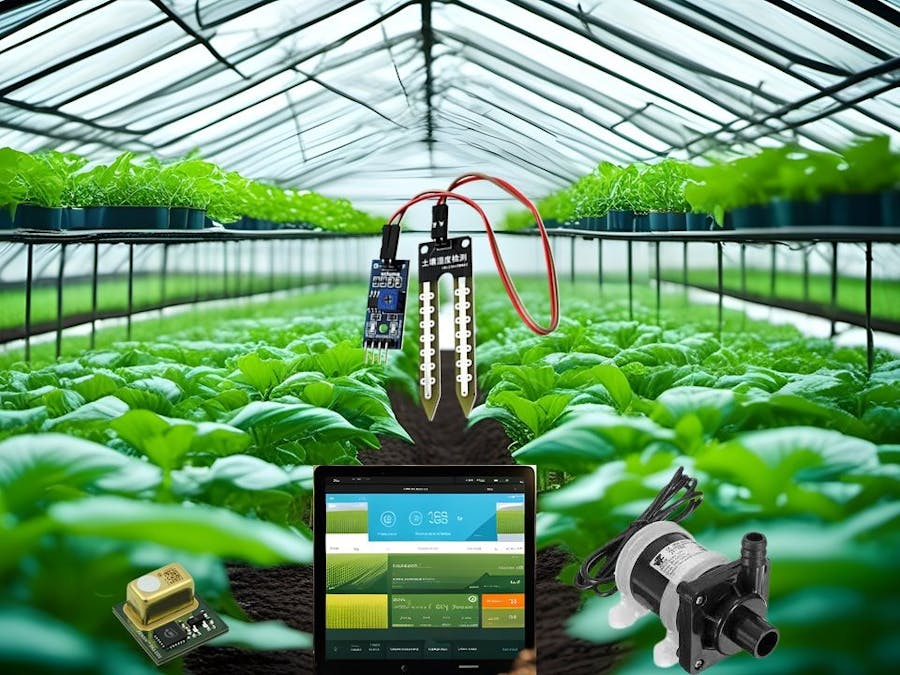Introduction
The following problems commonly encountered in farming : Inefficient Water Usage, Inadequate air quality, including improper ventilation and carbon dioxide levels. Smart Farming System: Implement automated irrigation & ventilation systems based on the sensor data to optimize crop growth & productivity. I have build a comprehensive smart farming system using the PSoC™ 6 Wi-Fi BT Prototyping Kit: CY8CPROTO-062-4343W, XENSIV PAS CO2 Mini Board, and BLDC Shield IFX007T etc. This system incorporates sensor data, automation, and data analysis to optimize irrigation, ventilation, and environmental conditions for crop growth.
The CY8CPROTO-062-4343W is a development kit by Cypress Semiconductor designed for IoT applications. It features a PSoC 6 MCU with dual-core processing capabilities, combining high-performance and low-power cores. This kit integrates Wi-Fi and Bluetooth connectivity via the CYW4343W combo chip, allowing for versatile wireless communication. With various onboard peripherals and memory resources, developers can easily prototype IoT devices. It supports the PSoC Creator IDE and Micro Python also, simplifying the hardware and software development process. Additionally, the kit offers security features, cloud connectivity, and RTOS support, making it a comprehensive platform for IoT development.
The Xensiv PAS CO2 sensor is a state-of-the-art sensor designed for accurate carbon dioxide (CO2) measurement. It utilizes Photoacoustic Spectroscopy (PAS) technology, known for its precision and reliability in gas sensing. This sensor provides real-time CO2 concentration data, making it ideal for applications like indoor air quality monitoring and HVAC control. With its compact design and low power consumption, the Xensiv PAS CO2 sensor is suitable for integration into various devices and systems. It offers high sensitivity and a wide measurement range, ensuring accurate and responsive CO2 monitoring.
WorkingThe Infineon PSoC 6 CY08PROTO-062-4343W is programmed in Thonny using the MicroPython programming language. The PSoC6 is connected to two sensors: the Infineon Xensiv PAS CO2 sensor and a Generic Soil Moisture Sensor. The Xensiv PAS CO2 sensor is linked to the I2C communication lines, specifically SCL and SDA, which are connected to the PSoC6 pins P6.0 and P6.1, respectively. The Moisture Sensor is connected to the PSoC6's analog-to-digital converter (ADC) input, specifically GPIO Pin P10.0(Input). These sensors receive their power supply from different sources. The Xensiv PAS CO2 and Moisture sensors are powered by a +3.3V supply drawn from the PSoC6 pin VDDIO, while a separate adapter is used to provide a +12V supply to the sensors and the Infineon BLDC Shield IFX007T. Further wiring details can be found in the schematic figure below.
As mentioned earlier, the purpose of this setup is to facilitate smart farming within a greenhouse. The target environmental parameters are to maintain the CO2 level above 720 ppm and the soil moisture level above 42%. If the CO2 level drops below 720 ppm, the PSoC6 GPIO Pin P6.2 goes high, triggering a signal to illuminate an LED and activating an input pin (D7) on an Arduino Uno board connected to the BLDC Shield IFX007T. Consequently, the BLDC Shield IFX007T activates the ventilation Fan, which remains on until the CO2 level surpasses 720 ppm.
Regarding soil moisture, the sensor continuously measures the soil moisture and sends an analog signal to the PSoC6 GPIO Pin P10.0 (input). If the soil moisture level falls below 42%, the PSoC6 sets the GPIO Pin P0.5 high, sending a signal to illuminate an LED and activate an input pin (D8) on an Arduino Uno board connected to the BLDC Shield IFX007T. Consequently, the BLDC Shield IFX007T activates the irrigation pump, which remains on until the soil moisture sensor level exceeds 42%. The sensor constantly monitors the status and issues commands to control the motors accordingly.
Micro Python Quick reference for the PSoC6 click here
Future WorkIn our future work, we plan to develop an application or interface that enables farmers to remotely monitor all the activities, readings, and even detect and address any potential errors in the system. Additionally, we aim to integrate spectral sensors into our setup to facilitate remote monitoring of plant health. This will allow farmers to keep a close eye on the well-being of their plants from a distance, providing them with valuable insights for more effective greenhouse management and crop care.










Comments
Please log in or sign up to comment.